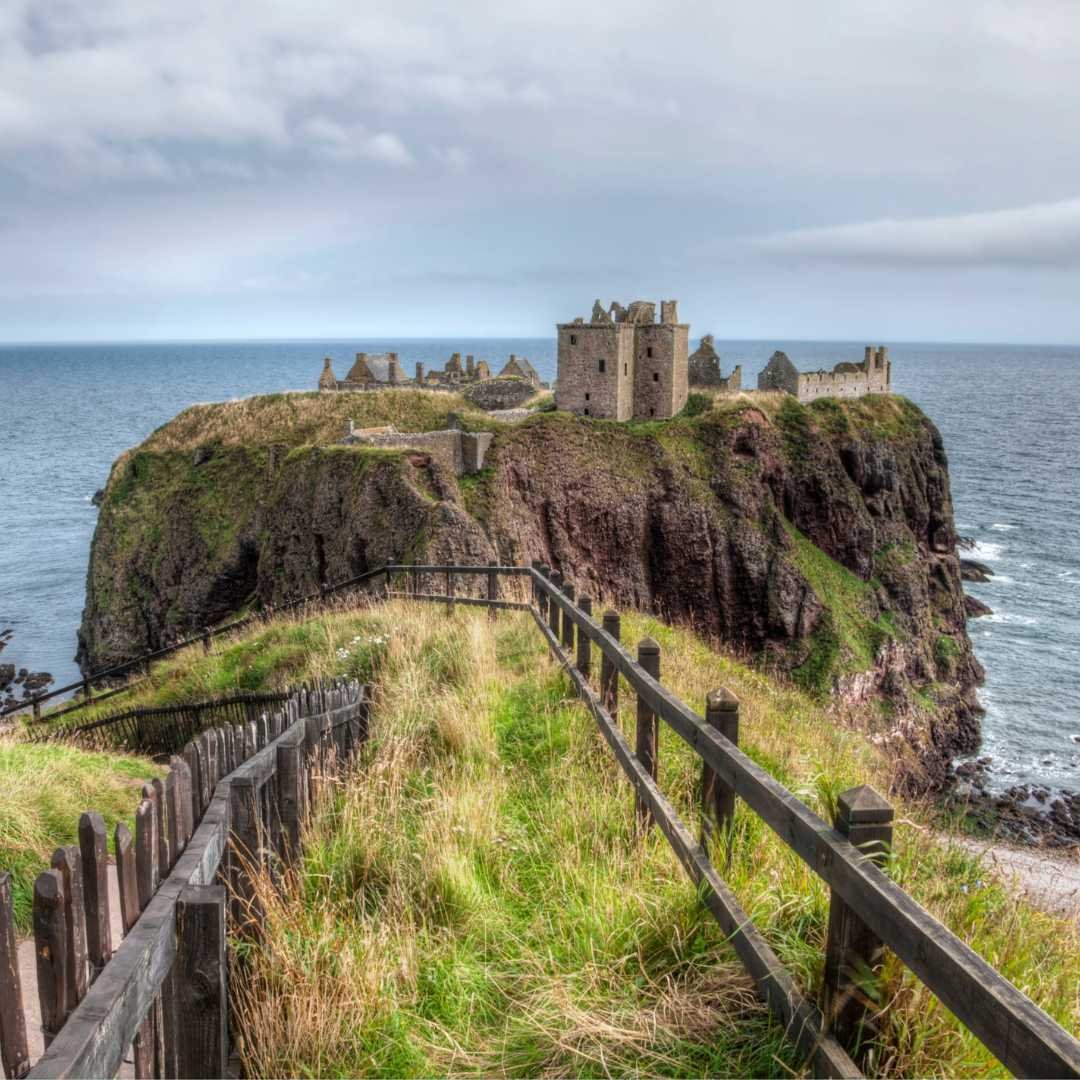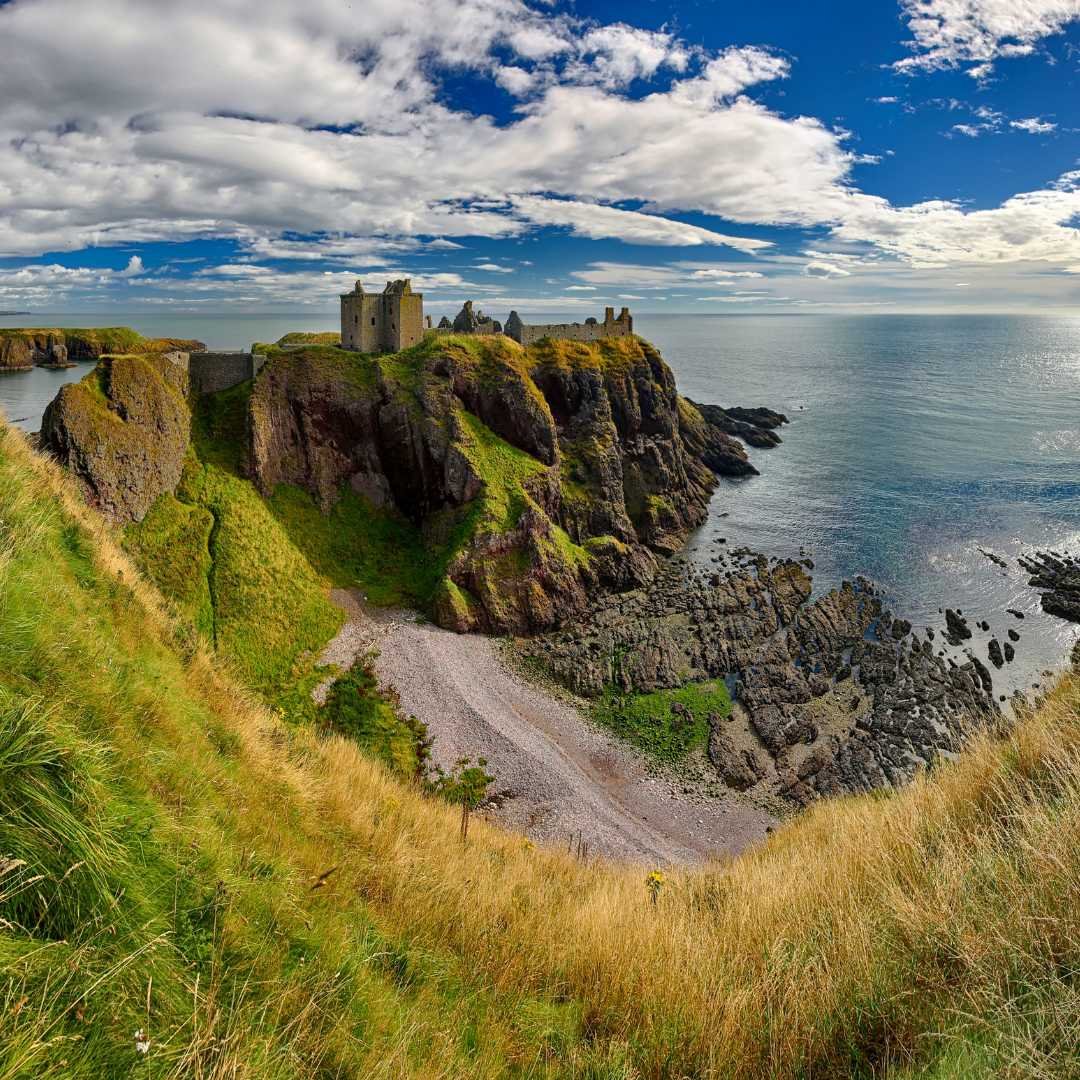Scotland’s Castles: Types & Most Popular
Scotland is home to a vast array of castles, with estimates of over 3,000 built across the country over the centuries. These impressive structures served a variety of purposes throughout Scotland's complex history, from mighty fortresses built for defence to elegant manor houses designed for comfort and status.
The first castles emerged in Scotland in the 12th century, built initially by Norman nobles invited to Scotland by King David I. These early castles were simple motte and bailey constructions, with a wooden tower on a raised earthwork mound protected by an enclosing wooden fence. Over time, castles evolved into grander stone structures with high curtain walls and imposing keeps, designed to withstand sieges.
At Scotland’s Wild, our friendly, story-telling guides have led thousands of trips through Scotland. We share history, legends and tales to entice people to visit this incredible country!
If you’d like to check-out our selection of tours, from day trips to island hopping multi-day adventures - click here.
Castles served as centers of administration and power for both noble families and royals like King Edward I of England, who constructed imposing castles to subdue the Scots during the Wars of Independence in the late 13th and early 14th centuries. By the 15th and 16th centuries, castles took on more lavish forms as grand residences, with ornate architecture and features like gardens that reflected the Renaissance spirit.
From rugged medieval fortresses to refined manor houses, Scotland's castles represent over 900 years of changing architectural styles and purposes. Their dramatic ruins continue to dominate landscapes across Scotland today, from the urban centre of Edinburgh to the remote northern Highlands.
The castles stand as iconic reminders of Scotland's turbulent history and evolution. Let’s dive into the types of castle there are and some of the most popular and visited castles in Scotland today.
Types of Castles
Scotland has a wide variety of castle types that developed over centuries. Some of the main castle styles found in Scotland include:
Tower Houses
Tower houses were simple rectangular or L-shaped buildings usually three to five stories high, made of stone.
They originated in the 14th century and were the most common type of castle built. The main feature was the strong tower that provided defence and status.
Courtyard Castles
Courtyard castles, emerging in the 14th century, had lower curtain walls enclosing a central courtyard. Buildings like the great hall and kitchens lined the inside of the courtyard.
These provided more space and comfort for more people compared to tower houses which were predominantly for one family.
Enclosure Castles
Enclosure castles were surrounded by high stone curtain walls, sometimes round in shape. They had other buildings like halls, kitchens, and stables clustered in the middle.
The outer walls provided the main defense. Caerlaverock Castle (Shown in picture) is a prime example of an enclosure castle.
Tower Castles
Tower castles combined the defence of a tower house with the comforts and open space of a courtyard castle.
They had a large stone tower as well as lower curtain walls with buildings inside the courtyard. Doune Castle is a classic tower castle example (Shown in picture).
Most Visited Castles in Scotland
Edinburgh Castle
Edinburgh Castle is one of the most iconic castles in Scotland, sitting high atop Castle Rock in Scotland's capital city of Edinburgh. With origins dating back to the 12th century, Edinburgh Castle has served as a royal residence, military garrison, and prison over its long history.
The castle is built on the remnants of an extinct volcano, giving it a naturally defensive position overlooking the city below. It has been besieged over 30 times throughout history, making it one of the most attacked places in the world.
An interesting fact about Edinburgh Castle is that it is rumoured to be home to a ghost dog that haunts the castle's dog cemetery. The story goes that a pet dog belonging to a soldier was so devastated when his master died that the dog refused to leave his grave, eventually starving to death. People claim to sometimes see or hear a spectral dog roaming the castle grounds.
Stirling Castle
Stirling Castle is one of Scotland's largest and most important castles, located in Stirling. With origins dating back to at least the 12th century, it sits atop Castle Hill, a volcanic crag, giving it a naturally defensive position.
Stirling Castle has served as a royal residence and a military stronghold over the centuries. It was the childhood home of Mary, Queen of Scots and later used as a refuge by King James VI. Significant events in Scottish history occurred at Stirling, including battles during the Wars of Independence against England.
One of the most interesting facts about Stirling Castle is that it's said to be located on a strategic position that allowed it to control the majority of Medieval Scotland. Sitting at the lowest crossing point of the River Forth, it was perfectly positioned to guard the routes between the Highlands and Lowlands. This key location made Stirling a prized possession during times of war.
Urquhart Castle
Urquhart Castle is located on the banks of Loch Ness in the Scottish Highlands. Its iconic ruined walls and towers sit against the beautiful backdrop of the loch and mountains.
The castle has a long and storied history, with origins dating back to the 13th century. It was built in the 1200s, underwent expansion in the 14th century, and saw conflict during the Wars of Scottish Independence against King Edward I of England.
Urquhart fell in and out of English and Scottish control over the centuries.
An interesting fact about Urquhart Castle is that it was likely the last place in the British Isles to have an organised siege using catapults as weapons in 1690. The ruins contain the remains of a stone-throwing trebuchet that was used by Jacobite forces during the siege. This provides a glimpse into medieval siege warfare.
Dunnottar Castle
Dunnottar Castle is a dramatic ruined cliff top fortress located just outside Stonehaven in Aberdeenshire. Perched upon a rocky headland towering over the North Sea, Dunnottar Castle is undoubtedly one of the most spectacular castles in all of Scotland.
The lands on which Dunnottar Castle sits were home to Pictish people as far back as the 3rd century AD. The surviving buildings largely date to the 15th and 16th centuries, when Dunnottar Castle was fortified to defend against English invasion. The castle played a key role in the Wars of Scottish Independence, with Sir William Wallace capturing Dunnottar Castle in 1297.
Dunnottar's most famous moment in history came in 1652, when the Honours of Scotland (the Scottish crown jewels) were smuggled out of the castle right under the noses of Oliver Cromwell's invading army. This remarkable event allowed the crown jewels to be preserved and survive to this day.
An interesting fact about Dunnottar Castle is that it likely served as inspiration for the castle featured in the 1990 film Hamlet, starring Mel Gibson. The evocative ruins of Dunnottar Castle certainly match the mood and setting of Shakespeare's famous tragedy.
Eilean Donan Castle
Eilean Donan Castle is located on a small tidal island where three lochs meet - Loch Duich, Loch Long and Loch Alsh - in the western Highlands of Scotland. With a picturesque setting and iconic architecture, Eilean Donan is one of the most recognized castles in Scotland.
The first fortified castle was established in the 13th century as a stronghold of the Clan MacKenzie. The original castle was likely built upon the remains of an early Christian monastic cell dedicated to Bishop Donan of Eigg. Over the next several centuries, the castle passed between Scottish clans and was expanded and remodeled.
In 1719, the Jacobite supporters of the Spanish garrison were defeated by English ships and the castle was bombarded until partially destroyed. For nearly 200 years, Eilean Donan lay in ruins until Lieutenant Colonel John MacRae-Gilstrap purchased the island in 1911 and spent the next 20 years restoring the castle to its former glory.
Today, Eilean Donan Castle is one of the most frequently photographed castles in Scotland. An interesting fact is that in the 1990s, the castle served as the headquarters of MI6 in the James Bond film The World Is Not Enough.
Discover this iconic Scottish castle and see the breathtaking Isle of Skye on a 3-day tour that will bring you up through the Highlands and onto Skye. Check out the itinerary here!
Other Notable Castles
Caerlaverock Castle
Caerlaverock Castle (Pictured before) is a moated triangular castle first built in the 13th century. It is located in Dumfries and Galloway in southern Scotland. The castle has a distinctive triangular plan with a double tower gatehouse. It was besieged by the English during the Wars of Scottish Independence in 1300.
Doune Castle
Doune Castle (Pictured before) is a medieval stronghold near the village of Doune, in the Stirling district of central Scotland. Built in the late 14th century, Doune Castle features a 100-foot gatehouse and a courtyard with the remains of a Great Hall and private chambers. It has been used for filming movies such as Monty Python and the Holy Grail.
Balmoral Castle
Balmoral Castle is located in Royal Deeside, Aberdeenshire and has been one of the residences of the British royal family since 1852. It was purchased by Prince Albert and Queen Victoria as a private residence. Balmoral Castle is built from granite and is an example of Scottish baronial architecture. The castle grounds cover over 50,000 acres.
Castles have played an important role in Scottish history and culture for centuries. From mighty fortresses built for defense to opulent palaces housing royalty, these iconic structures tell the story of Scotland's past.
This guide has provided an overview of the main types of castles found in Scotland, ranging from simple tower houses to elaborate Renaissance palaces. We've also highlighted some of the most popular castles to visit, including Edinburgh Castle, Stirling Castle, and Eilean Donan Castle.




















